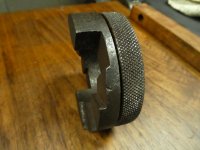Actually... I take it back. It seemed worae this morning than i does now. I tilted the tool up and the rake isnt that bad. Im going roll with this for now but i dont like how the rake changes with height.
You need two things:
A - More tool holders, back-rake built-in, left and right as well as straight-ahead.
WHEN used wisely, it is NOT required to grind the
top of a blank at all. Just the front and side(s). The blanks can be touched-up faster. They last waay longer.
B - heavy "shims" that go between the top of the rocker, and the underside of the Armstrong/Williams holder. That divorces gross height from gross tilt.
- WITH those shims AND built-in back rake? You may then also pull the rocker crescent out, flip the ring flat-side up, shim to height, stand heavier cuts with less vibration or having the tool move.
BE AWARE..
- that the rocker serves as a form of safety. Too heavy a cut, it is MEANT to be able to slip down and move the tool OUT of the heavy load zone.
BE AWARE..
- that the "safe" way to align the toolholder ALSO means IF too heavy a cut, it will swing... and swing AWAY from engagement, NOT dig-in deeper ... if the force is so high as to rotate the toolpost at all. One of the several reasons they make left, right, and straight ahead toolholders for the lantern (and double-post) style toolposts.
A "lantern" TP is not as "dumb" as first appears ... or they'd not have remained in
use for more than a hundred years.
It can be positioned very creatively. And re-positioned as required. Rapidly,even.
It can serve as a "fuse" to reduce the risk of damage from crashes.
Good thing to do, learning the lantern FIRST.
Stick with it!
It can break you of picking up bad habits, early. THEN you can "graduate" to the 4-Way.
A 4-Way is almost NEVER "populated" all sides. One, two, often. Three? Only sometimes. Keep a side open for "whatever" might become needful in the moment. Drill or boring-bar holder, pressure or cut knurls, for example..
A 4-Way needs but the most modest collection of shims and/or wedges. Not as if there was an infinite range of blanks in your stash, is it? Make some wedges. They can set back-rake as well as control tip height.
It needs
No expensive, extensive "toolholder" collection.
Carbides are optional, not required. I can't really be bothered.
No longer running a "factory", after all. HSS/Cobalt & Tantung-G are cheaper.
What do you expect to turn that a Crucible CPM Rex 95 or a Tantung-G Stellite CANNOT cut, anyway?

Annnnnd .. as to
consumables?
I'd far rather buy fresh veg, steak, & seafood than toolholders and
consumable inserts.
Cheap Iyam. Lazy as well.














